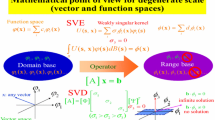Abstract
The paper performs analytical and numerical investigation of the true and spurious eigensolutions of an elliptical membrane using the real-part boundary integral equation method (BIEM) following the successful work on a circular case by using the dual boundary element method (BEM) (Kuo et al. in Int. J. Numer. Methods Eng. 48:1401–1422, 2000). We extend to the elliptical case in this paper. To analytically study the eigenproblems of an elliptical membrane, the elliptical coordinates and Mathieu functions are adopted. The fundamental solution is expanded into the degenerate kernel by using the elliptical coordinates and the boundary densities are expanded by using the eigenfunction expansion. The Jacobian terms may exist in the degenerate kernel, boundary density and boundary contour integration but they can cancel each other out. Therefore, the orthogonal relations are reserved in the boundary contour integral. It is interesting to find that the BIEM using the real or the imaginary-part kernel to deal with an elliptical membrane yields spurious eigensolutions. This finding agrees with those corresponding to the circular case. The spurious eigenvalues in the real-part BIEM are found to be the zeros of the mth-order (even or odd) modified Mathieu functions of the second kind or their derivatives. To verify this finding, the BEM is implemented. Furthermore, the commercial finite-element code ABAQUS is also utilized to provide eigensolutions for comparisons. It is found that good agreement is obtained.
Similar content being viewed by others
References
Tai GRG, Shaw RP (1974) Helmholtz equation eigenvalues and eigenmodes for arbitrary domains. J Acoust Soc Am 56:796–804
De Mey G (1976) Calculation of eigenvalues of the Helmholtz equation by an integral equation. Int J Numer Methods Eng 10:59–66
De Mey G (1977) A simplified integral equation method for the calculation of the eigenvalues of Helmholtz equation. Int J Numer Methods Eng 11:1340–1342
Hutchinson JR, Wong GKK (1979) The boundary element method for plate vibrations. In: Proceedings of the ASCE seventh international conference on electronic computation, pp 297–311
Hutchinson JR (1984) Boundary method for time-dependent problems. In: Proceedings of the fifth engineering mechanics division conference, ASCE, WY, pp 136–139
Yasko M (2000) BEM with the real-valued fundamental solutions for the Helmholtz equation. In: Proceedings of the seventh international congress of sound and vibration, Germany, pp 2037–2044
Duran M, Miguez M, Nedelec JC (2001) Numerical stability in the calculation of eigenfrequencies using integral equations. J Comput Appl Math 130:323–336
Kang SW, Lee JM, Kang YJ (1999) Vibration analysis of arbitrarily shaped membranes using non-dimensional dynamic influence function. J Sound Vib 234(1):455–470
Chen JT, Chang MH, Chung IL, Cheng YC (2002) Comment on eigenmode analysis of arbitrarily shaped two-dimensional cavities by the method of point matching. J Acoust Soc Am 111(1 Part 1)
Kamiya N, Andoh E, Nogae K (1996) A new complex-valued formulation and eigenvalue analysis of the Helmholtz equation by boundary element method. Adv Eng Softw 26:219–227
Yeih W, Chen JT, Chen KH, Wong FC (1998) A study on the multiple reciprocity method and complex-valued formulation for the Helmholtz equation. Adv Eng Softw 29(1):1–6
Kuo SR, Chen JT, Huang CX (2000) Analytical study and numerical experiments for true and spurious eigensolutions of a circular cavity using the real-part dual BEM. Int J Numer Methods Eng 48:1401–1422
Chen JT, Lin SY, Chen KH, Chen IL (2004) Mathematical analysis and numerical study of true and spurious eigenequations for free vibration of plates using real-part BEM. Comput Mech 34:165–180
Lee WM, Chen JT (2008) Analytical study and numerical experiments of true and spurious eigensolutions of free vibration of circular plates using real-part BIEM. Eng Anal Bound Elem 32:368–387
Shi J, Chen W, Wang C (2009) Free vibration analysis of arbitrary shaped plates by boundary knot method. Acta Mech Solida Sin 22(4):328–336
Chen W, Shi J, Chen L (2009) Investigation on the spurious eigenvalues of vibration plates by non-dimensional dynamic influence function method. Eng Anal Bound Elem 33(6):885–889
Chen JT, Lee JW, Cheng YC (2009) On the spurious eigensolutions for the real-part boundary element method. Eng Anal Bound Elem 33:342–355
Chen JT, Liu LW, Hong H-K (2003) Spurious and true eigensolutions of Helmholtz BIEs and BEMs for a multiply-connected problem. Proc R Soc Lond A 459:1891–1925
Troesch BA, Troesch HR (1973) Eigenfrequencies of an elliptic membrane. Math Comput 27(124):755–765
Hong K, Kim J (1995) Natural mode analysis of hollow and annular elliptical cylindrical cavities. J Sound Vib 183(2):327–351
Buchanan GR, Peddieson J (2005) A finite element in elliptic coordinates with application to membrane vibration. Thin-Walled Struct 43:1444–1454
Chen JT, Chen CT, Chen IL (2007) Null-field integral equation approach for eigenproblems with circular boundaries. J Comput Acoust 15(4):401–428
Zhang S, Jin J (1996) Computation of special functions. Wiley, New York
Abramowitz M, Stegun IA (1965) Handbook of mathematical functions with formulas, graphs and mathematical tables. Dover, New York
Morse P, Feshbach H (1953) Method of theoretical physics. McGraw-Hill, New York
Chen JT, Chen KH (1998) Dual integral formulation for determining the acoustic modes of a two-dimensional cavity with a degenerate boundary. Eng Anal Bound Elem 21(2):105–116
Dongarra JJ, Bunch JR, Moler CB, Stewart GW (1979) LINPACK users’ guide. Philadelphia, SIAM
Author information
Authors and Affiliations
Corresponding author
Rights and permissions
About this article
Cite this article
Chen, JT., Lee, JW. & Leu, SY. Analytical and numerical investigation for true and spurious eigensolutions of an elliptical membrane using the real-part dual BIEM/BEM. Meccanica 47, 1103–1117 (2012). https://doi.org/10.1007/s11012-011-9496-z
Received:
Accepted:
Published:
Issue Date:
DOI: https://doi.org/10.1007/s11012-011-9496-z




